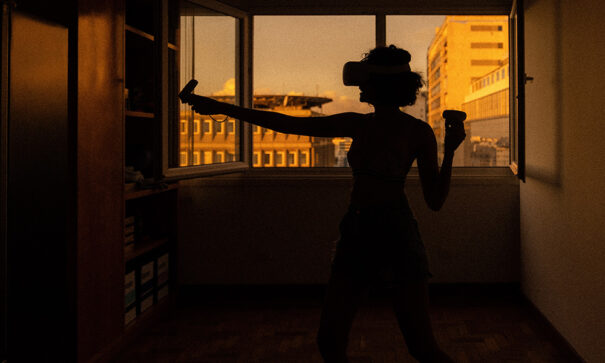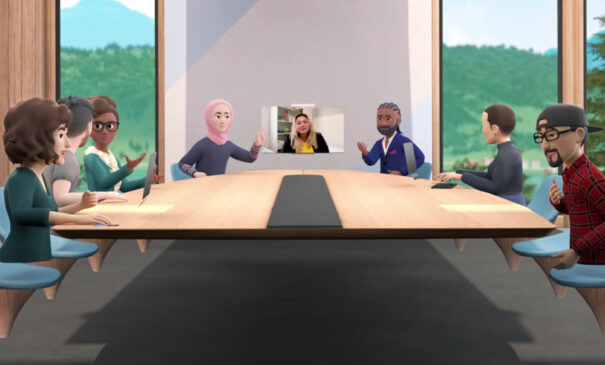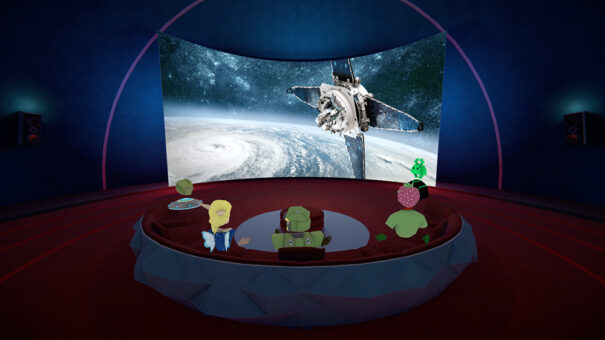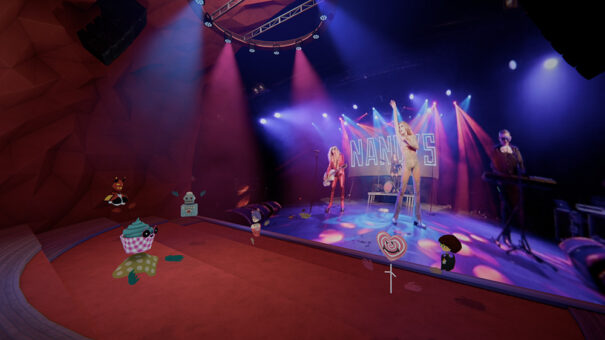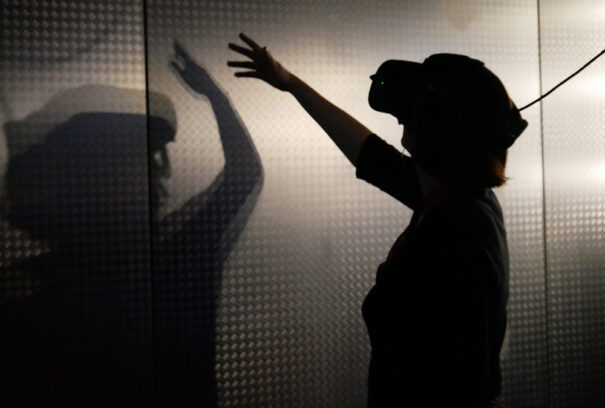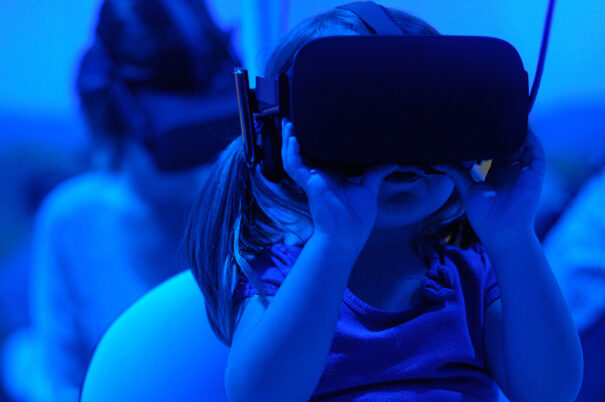Metaverso y broadcast: ¿Dos mundos obligados a entenderse?
El metaverso, impulsado por la evolución de Facebook a Meta, está en boca de todos. Pero, ¿realmente hay una gran oportunidad para la industria del entretenimiento tras este concepto? Edgar Martín-Blas Méndez, CEO y director creativo de Virtual Voyagers, encuentra lugares comunes entre el mundo virtual y el mercado broadcast.
Para entender la vorágine que trae consigo el metaverso, primero hay que entender lo que es. Aunque, la realidad es que, más allá de pruebas de conceptos y acercamientos limitados, todavía no existe una aproximación tangible que nos permita definirlo a la perfección.
 El metaverso, sobre el papel y los deseos de los grandes gigantes tecnológicos, implica la creación de mundos virtuales a escala humana en la que los usuarios podrán interactuar de forma natural e incluso realizar actividades “físicas”, como asistir a un concierto, jugar al tenis o volar en un avión. Conectándose al metaverso, las personas podrán interactuar con avatares que se beneficiarán de las últimas tecnologías asociadas a las gafas y dispositivos de control de realidad virtual.
El metaverso, sobre el papel y los deseos de los grandes gigantes tecnológicos, implica la creación de mundos virtuales a escala humana en la que los usuarios podrán interactuar de forma natural e incluso realizar actividades “físicas”, como asistir a un concierto, jugar al tenis o volar en un avión. Conectándose al metaverso, las personas podrán interactuar con avatares que se beneficiarán de las últimas tecnologías asociadas a las gafas y dispositivos de control de realidad virtual.
 Aquellos interesados no tendrán que desplazarse hasta el desierto de California para disfrutar del festival de música de Coachella, ya que podrán comprar su entrada para disfrutar de conciertos en exclusiva con sus amigos. Tampoco será necesario quedar en una sala de cine o en un hogar para ver una película: ¿por qué no aprovechar una suscripción de Netflix para ver y comentar, en tiempo real, una película? De hecho, ni siquiera hará falta coger un billete de avión para conocer el cruce de Shibuya. ¿Por qué no formar parte de la recreación virtual?
Aquellos interesados no tendrán que desplazarse hasta el desierto de California para disfrutar del festival de música de Coachella, ya que podrán comprar su entrada para disfrutar de conciertos en exclusiva con sus amigos. Tampoco será necesario quedar en una sala de cine o en un hogar para ver una película: ¿por qué no aprovechar una suscripción de Netflix para ver y comentar, en tiempo real, una película? De hecho, ni siquiera hará falta coger un billete de avión para conocer el cruce de Shibuya. ¿Por qué no formar parte de la recreación virtual?
Estos universos traen consigo varias preguntas. ¿Habrá un metaverso hegemónico? ¿Cuáles son los competidores en esta batalla? ¿De qué manera podrá captar los elementos interactivos para mejorar las interacciones humanas? ¿Qué papel puede tener el broadcast en el metaverso?
Guía para principiantes del metaverso
Martín-Blas define al metaverso, por encima de todo, como una evolución. Es un paso más allá del internet que conocemos: “Venimos de un entorno web plano, basado en pantallas 2D e interacción con clicks”. En esta nueva fase los usuarios podrán interactuar, participar y sentirse inmersos en un mundo virtual.
El lector más cercano al mundo digital podrá encontrar similitudes a este concepto en Second Life, el universo virtual nacido en 2003 y que a fecha de 2018 seguía reuniendo a medio millón de usuarios recurrentes cada mes; o Roblox, un juego multijugador que permite crear mundos interactivos sostenidos por videojuegos que cuenta con 190 millones de jugadores en todo el mundo. La gran diferencia con el metaverso es que, si bien las propuestas anteriores se centraban en generar un mundo paralelo virtual, el metaverso busca la conjunción del mundo virtual y real con el añadido extra de beneficiarse de hardware que proporciona la inmersividad.
Este entorno podrá presentarse de forma centralizada o descentralizada. Esta clave protagoniza gran parte de la disputa por la hegemonía de esta propuesta interactiva. El usuario podrá formar parte de un metaverso estructurado en nodos, de modo que pueda “saltar” entre mundos con libertad de movimiento (algo que representa la utopía de la web 3.0), o un proveedor podrá centralizar el acceso a los contenidos ofreciendo una suerte de marketplace o punto de origen para todas las experiencias. De esta forma, Meta, Google o Microsoft podrían ofrecer un servicio con características que capten la atención de los consumidores y culmen sus expectativas, aglutinando a empresas, artistas o incluso iniciativas públicas. Por supuesto, todo este entorno puede ser completamente monetizable, ya sea con divisas en circulación global o con criptomonedas.
Meta, Google y Microsoft, en el Metaverso
La carrera por la innovación ha caracterizado las grandes compañías tecnológicas. En mayor o menor medida, han disputado su hegemonía en mercados como la tecnología móvilthe IPTV, los asistentes virtuales or the conversación digital. The metaverso podría ser el siguiente gran terreno de juego, en tanto que lo tangible se pierde para generar oportunidades virtuales.
Matthew Kanterman and Nathan Naidu, analistas especializados en tecnología del diario económico y empresarial Bloomberg, apuntan a que, dentro de tan solo seis años, el metaverso representará un mercado de 800.000 millones de dólares, gracias no solo a las posibles aplicaciones sociales y empresariales de Meta, Google and Microsoft, sino por los desarrollos de empresas de videojuegos como Roblox, Activision Blizzard or Take-Two. De hecho, a día de hoy, varias compañías están desarrollando juegos como servicio ubicados en mundos virtuales en constante expansión y actualización que buscan nexos con la realidad. Entre ellas, Epic Games. Los desarrolladores del célebre y cada vez más extendido Unreal Engine en producciones virtuales ya han ofrecido a través de Fortnite, su videojuego más exitoso, conciertos exclusivos de estrellas de la música como Travis Scott, Marshmello or Ariana Grande.
Al margen de la competición por la hegemonía del metaverso, es fundamental la apuesta por un hardware accesible que haga que se cumpla la estimación de la compañía de Zuckerberg: que, antes de 2032the metaverso sea una realidad tan extendida como pudo ser la llegada de Facebook a los teléfonos inteligentes de todo el mundo.
Interacciones humanas a través de la tecnología
Meta ya cuenta con unas gafas de realidad virtual que permiten al consumidor acercarse al concepto de metaverso: Meta (antes Oculus) Quest 2. Estas gafas, por ahora, ofrecen reconocimiento de movimiento, controles gestuales and visualización 360. No obstante, su próxima generación, conocida como Project Cambria, dará un paso más en la inmersividad, con características como la capacidad de captar y reproducir a través de un avatar expresiones faciales, reconstruir en tiempo real objetos presentes en el entorno del usuario con funciones de realidad mixta, un diseño más ergonómico y compacto, o trackeos de movimientos más completos.
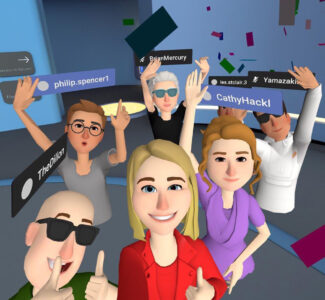 Como no podría ser de otra forma, sus competidores trabajan en la misma línea. Apple planea presentar su primer headset entre 2022 y 2023. Más orientado a facilitar las interacciones sociales que al metaverso, diferentes medios apuntan a características como la inclusión de cámaras para captar directamente las expresiones faciales y gestuales de los usuarios, detección espacial, audio inmersivo, funciones de realidad mixta con características de realidad aumentada, y aplicaciones específicas de gaming, vídeo en streaming y videoconferencias.
Como no podría ser de otra forma, sus competidores trabajan en la misma línea. Apple planea presentar su primer headset entre 2022 y 2023. Más orientado a facilitar las interacciones sociales que al metaverso, diferentes medios apuntan a características como la inclusión de cámaras para captar directamente las expresiones faciales y gestuales de los usuarios, detección espacial, audio inmersivo, funciones de realidad mixta con características de realidad aumentada, y aplicaciones específicas de gaming, vídeo en streaming y videoconferencias.
De manera paralela, Microsoft ya tiene en el mercado sus HoloLens (por ahora dirigido a ámbitos industriales, pero que podrían dar su salto eventualmente al mercado del consumidor); Sony apuesta por PS VR2, si bien limita su alcance a Playstation 5; y Google sigue trabajando en Project Iris: con fecha de lanzamiento prevista para 2024, esta solución sería la evolución definitiva de las fallidas Google Glass.
¿El metaverso tiene cabida en el broadcast?
El metaverso, configurable como una prolongación no solo del mundo real sino de todo el entretenimiento y los encuentros sociales que tiene en él, puede ofrecer oportunidades a diferentes compañías dentro de la industria broadcast. Ya sea desde el punto de vista meramente técnico o desde el de la creación de contenidos, la promesa de una nueva ventana con contenido inédito está llevando a las compañías de contenido a especializarse en la generación de contenido en VR con capacidades sociales.
 Martín-Blas considera que el broadcast es un punto clave para el metaverso por varias variables. Por un lado, el CEO y director creativo de Virtual Voyagers subraya la importancia del streaming 360º, 180º o 2D que se emite ya en los primeros acercamientos al metaverso. En segundo lugar, apuesta por las plataformas híbridas: entornos 3D que ocurren en tiempo real y cuyos elementos pueden ser “desde objetos a vídeos o música en directo”.
Martín-Blas considera que el broadcast es un punto clave para el metaverso por varias variables. Por un lado, el CEO y director creativo de Virtual Voyagers subraya la importancia del streaming 360º, 180º o 2D que se emite ya en los primeros acercamientos al metaverso. En segundo lugar, apuesta por las plataformas híbridas: entornos 3D que ocurren en tiempo real y cuyos elementos pueden ser “desde objetos a vídeos o música en directo”.
Como muestra, Horizon Venues, iniciativa de Meta que ya alberga conciertos exclusivos (con capacidad de interacciones sociales) de bandas de primer nivel, como Foo Fighters. La propia Virtual Voyagers colaboró estrechamente con Meta, junto con Supersphere L.A., para crear un editor en tiempo real de conciertos.
Nuevas narrativas o formatos mejorados
El directo, como aglutinador de atención y multitudes, es una gran arma para el metaverso al igual que para el mundo broadcast. La exclusividad de un contenido y el encuentro social que puede suponer (al igual que pueda ser una reunión en un hogar para disfrutar cada año de Eurovisión) puede suponer oportunidades para las industrias creativas de forma complementaria a la oferta televisiva or VOD.
No obstante, hay que tener en cuenta que la narrativa puede funcionar de forma diferente en el metaverso. Martín-Blas compara el desarrollo de contenidos en el metaverso como “un gran parte temático” en el que “libremente puedes andar o interactuar”. “La historia se va desplegando según avanzas e incluso puedes interactuar con las personas que te encuentres en tu camino”, sentencia.
Una retransmisión deportiva en el metaverso
Estos axiomas del metaverso permiten imaginar cómo podría ser asistir a una retransmisión de un partido de baloncesto en el metaverso. El usuario, a través de un avatar, podría formar parte de una grada virtual, en la que reaccionar con amigos y desconocidos al tiempo que ve el encuentro. En el momento de la pausa publicitaria, podría tener el hilo publicitario habitual de las retransmisiones deportivas, pero también contenido comercial generado ex profeso para la cancha virtual.
En los instantes previos o posteriores al partido, o durante los intermedios, el usuario podría “levantarse” de su asiento y dirigirse a uno de los puestos interactivos situados en los aledaños del estadio. Desde allí, podría visualizar cámaras exclusivas del vestuario, comprar la equipación de su equipo favorito (tanto para sus avatares virtuales como para el mundo real) o pedir comida a domicilio en un puesto virtual de algún proveedor de comida rápida. Todo, como no podría ser de otra forma, tendría sus costes y beneficios para el rightholder, el broadcaster y el propio consumidor. Y, en cada momento, las barreras entre lo real y lo virtual se difuminarían.
Primeros pasos de los broadcasters en el metaverso
En la actualidad, estamos asistiendo a una fase de protometaversos. Martín-Blas los define como “pruebas de concepto o Metaversos muy limitados”. Estos primeros pasos, acelerados a consecuencia de la pandemia, han dado lugar a retransmisiones de deportes en directo o eventos con sus respectivos procesos de emisión, producción y edición. No obstante, “aún queda mucho que mejorar”.
En cualquier caso, Martín-Blas se muestra optimista por el desarrollo del metaverso: “En 2022 veremos avanzar este mundo ya que la inversión es enorme. Todos están metidos, sobre todo en Estados Unidos. La carrera ha empezado: se está descabezando el talento del mercado, comprando empresas y capturando el talento de la competencia. Estamos asistiendo a la creación de toda una industria. Llevará el tiempo, pero el resultado será que habrá nuevos líderes y no serán los mismos que ahora dominan el broadcast, la televisión y la radio”.
Creando metaversos desde la televisión
Bajo la perspectiva de la producción, el CEO de Digital Voyagers identifica a Unity and Unreal como dos engines “perfectos para dar forma a las nuevas herramientas del metaverso”. No obstante, en un principio, el broadcaster no se verá beneficiado necesariamente de su experiencia trabajando en entornos virtuales de realidad aumentada o realidad extendida: “La producción virtual parte de un hardware que soporta millones de polígonos y texturas enormes. En el metaverso, estamos hablando de real time: todo se reproduce en una gafa que tiene un chip móvil de bajo coste, por lo cual los desarrollos están más cercanos al mundo del videojuego que al de la producción virtual”.
Ante este contexto, Martín-Blas considera que la clave será aprender a optimizar entornos tridimensionales o de emisión en directo en base al hardware que hay en el mercado. De esta forma, el mundo broadcast podrá jugar sus cartas en el acercamiento del mundo real y el mundo virtual que supone el metaverso: “Ahora mismo, [crear contenidos para] Meta Quest 2 y PICO sería la línea de calidad/precio más competitiva y masiva. No obstante, en breve PlayStation lanzará su nueva gafa VR y Apple su dispositivo de realidad mixta”.
El consumidor: la pieza definitiva
El metaverso, sobre el papel, no puede ser más prometedor. Aporta ciertos de posibilidades al tercer sector para multiplicar su oferta y servicios en un entorno en expansión. El entretenimiento seguirá avanzando en su progresiva globalización, las interacciones sociales (con la respectiva avatarización de la sociedad) encontrarán nuevas máscaras en torno a las que desarrollarse y las empresas dispondrán de un canal inmersivo en el que acompañar tanto al presumer como al prosumer en su buyer journey.
Una vez completado el desarrollo de las tecnologías, la generación de contenido y el reparto de papeles hegemónicos en la industria tecnológica, el metaverso volverá a depender del usuario. Martín-Blas considera que “solo es cuestión de tiempo” de que el despliegue sea masivo: “Calculo que, en menos de cinco años, llegaremos a los 100 millones de usuarios del metaverso inmersivo, sin necesidad de pantallas planas”.
Thes promesas tecnológicas y las expectativas industriales están hechas. Ahora, el éxito del metaverso solo depende del apoyo que reciba desde el mundo real y las personas que lo habitan.
A report by Sergio Julián Gómez
Did you like this article?
Subscribe to us RSS feed And you will not miss anything.




